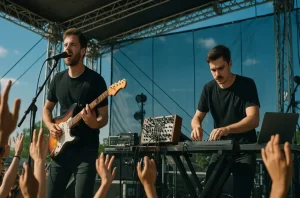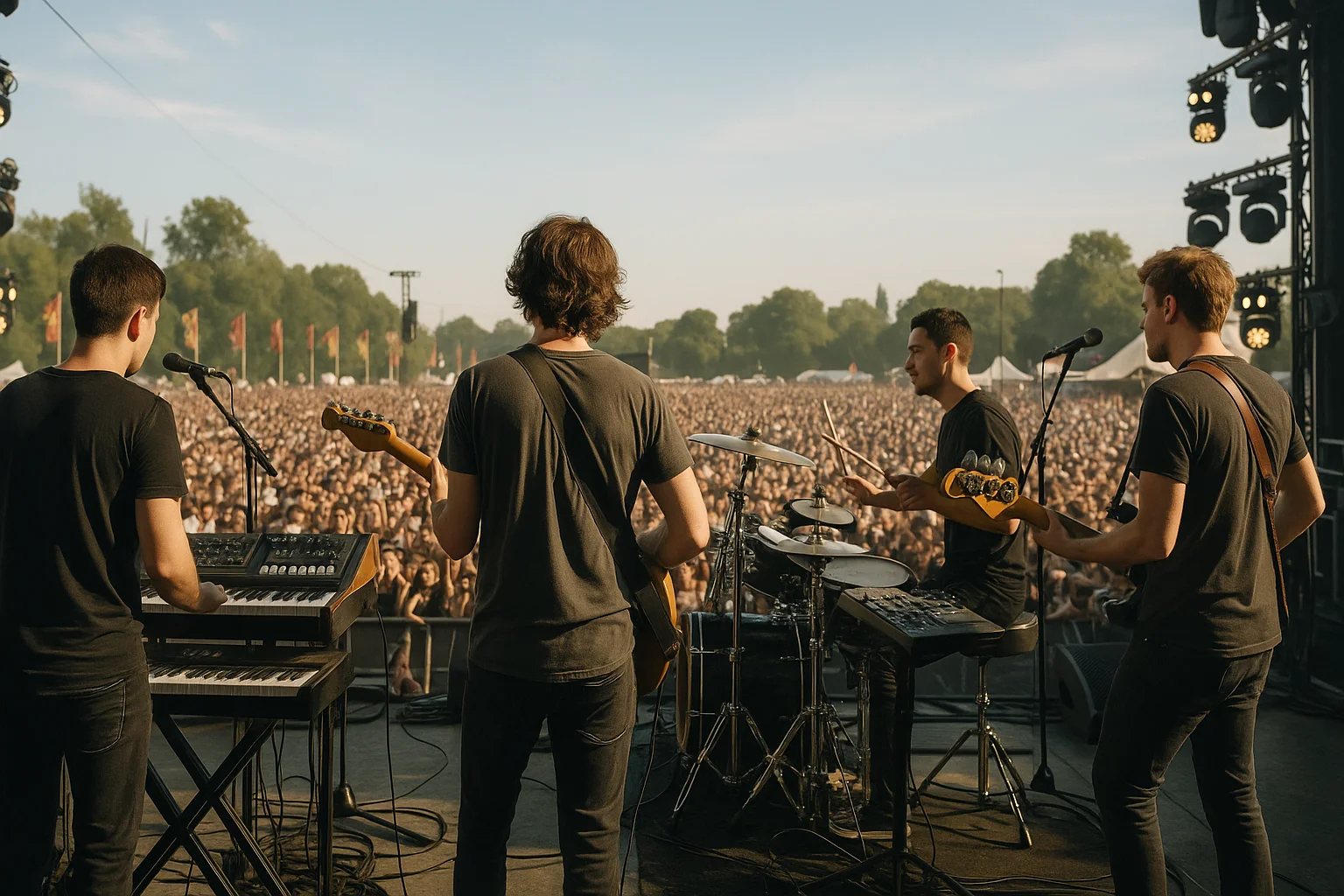Few bands have reshaped the soundscape of electronic music like The Prodigy. Emerging from the underground rave scene in early 1990s Britain, they ignited a cultural movement that fused punk energy with breakbeat rhythms and techno experimentation.
Behind their anarchic energy and explosive live performances were a group of dynamic individuals, each contributing a distinct style and presence.
Understanding the Prodigy members is essential to appreciating the band’s evolution and enduring legacy in British and global music history.
What is The Prodigy?

The Prodigy is an English electronic music group formed in 1990 in Braintree, Essex. The original line-up featured Liam Howlett (composer and producer), Keith Flint (dancer and later vocalist), Leeroy Thornhill (dancer and occasional keyboardist), and Maxim (MC and vocalist). Initially known for their rave-inspired tracks, the band evolved to blend electronic, punk, rock, and industrial elements.
Their debut in the UK’s early 90s rave scene coincided with a broader youth movement against the mainstream, and The Prodigy became its unofficial soundtrack.
They rose rapidly with chart-topping singles like Charly and Everybody in the Place, becoming one of the first acts to take underground rave music into the commercial mainstream.
Why Are The Prodigy So Influential in British Music?
The Prodigy were more than just a band, they were a phenomenon that bridged musical genres and societal subcultures.
At a time when British music was experiencing seismic shifts, The Prodigy delivered a sound that was raw, aggressive, and revolutionary. Their ability to fuse hardcore rave with punk attitude redefined what electronic music could be.
Over their career, they have achieved:
- Over 25 million records sold worldwide
- Seven consecutive UK number-one albums
- Numerous awards including Brit Awards, MTV Europe Music Awards, and Grammy nominations
Their influence also extended to fashion, youth culture, and political expression. The track Their Law, for example, was a direct response to the Criminal Justice and Public Order Act 1994, which sought to clamp down on unlicensed raves.
What Were The Prodigy’s Most Iconic Albums and Tracks?
![]()
A defining factor in The Prodigy’s legacy is their genre-defying discography. From rave anthems to controversial bangers, their albums have consistently set new benchmarks for electronic music.
Most Influential Albums by The Prodigy
| Album Name | Year Released | Key Tracks | UK Chart Position |
|---|---|---|---|
| Experience | 1992 | Charly, Out of Space, Everybody in the Place | #12 |
| Music for the Jilted Generation | 1994 | Voodoo People, No Good, Their Law | #1 |
| The Fat of the Land | 1997 | Firestarter, Breathe, Smack My Bitch Up | #1 |
| Invaders Must Die | 2009 | Omen, Warrior’s Dance, Take Me to the Hospital | #1 |
| The Day Is My Enemy | 2015 | Nasty, Wild Frontier | #1 |
Standout Tracks That Shaped Their Legacy
- Firestarter (1996): Keith Flint’s aggressive vocal debut and a UK chart-topper
- Breathe (1996): A global hit with a raw, haunting sound
- Smack My Bitch Up (1997): Controversial yet iconic, known for its infamous video
- Omen (2009): A comeback hit that introduced them to a new generation
These tracks helped reshape public perceptions of electronic music and made The Prodigy household names.
How Did Controversy Shape The Prodigy’s Public Image?
From the outset, The Prodigy were no strangers to controversy. Their music videos, lyrics, and live performances often courted public debate, whether due to provocative titles or visual intensity.
One of the most prominent examples was Smack My Bitch Up, which faced backlash for allegedly promoting misogyny. Its video was banned by several broadcasters and criticised by advocacy groups. However, the band maintained that the phrase referred to intensity and aggression in performance, not violence.
Similarly, the single Firestarter drew criticism from tabloids, with its aggressive tone and Keith Flint’s rebellious persona sparking headlines across the UK. Despite (or because of) the controversy, the track topped the UK charts and became an anthem of counter-culture rebellion.
These incidents didn’t hinder the band’s popularity, instead, they solidified their anti-establishment identity.
Who Are The Prodigy Members?

The Prodigy’s explosive sound and raw energy stem from the personalities that defined the group. Each member played a unique role in shaping the band’s legacy, blending creativity, chaos, and charisma into one of the most influential acts in electronic music history.
Key Members of The Prodigy:
- Liam Howlett – The Creative Force
Founder and composer, Liam Howlett crafted the band’s groundbreaking sound through innovative sampling and production. - Keith Flint – The Wild Frontman
Once a dancer, Keith became the fiery face of The Prodigy, embodying the spirit of 90s rave rebellion. - Maxim Reality – The Voice of Power
Maxim added raw lyrical aggression and street energy, giving the band its vocal intensity. - Leeroy Thornhill – The Rave Dancer
Known for his dynamic stage presence, Leeroy brought visual energy and rhythm to early live shows.
Together, these members created a movement that redefined British electronic music and global rave culture.
How Has The Prodigy’s Line-Up Changed Over the Years?
The Prodigy’s journey is not only marked by musical innovation but also by shifts in its line-up. Since forming in 1990, the group has undergone several transformations, with each member contributing to their iconic sound and stage identity.
The Original Formation
The band originally consisted of:
- Liam Howlett: Producer and primary composer
- Keith Flint: Dancer (later vocalist)
- Leeroy Thornhill: Dancer and keyboardist
- Maxim Reality: MC and vocalist
- Sharky (Sheila Chandra): Dancer and vocalist
Sharky left shortly after the group’s formation, before their first official release. Her departure turned The Prodigy into a four-man group, which became the band’s classic and most recognised line-up.
Peak Era Line-Up (1991–2000)
Throughout the 1990s, The Prodigy flourished with their four core members:
- Howlett remained the band’s creative engine.
- Flint rose to vocal prominence with Firestarter, becoming the band’s frontman.
- Maxim brought lyrical aggression and stage charisma.
- Thornhill contributed dynamic live energy with his height and rave-influenced movement.
This era produced landmark albums such as Experience, Music for the Jilted Generation, and The Fat of the Land, which brought them global acclaim.
In 2000, Leeroy Thornhill left the band to pursue solo projects, citing creative differences. This marked the first significant change in their core line-up.
Touring and Guest Members (2000s)
After Thornhill’s exit, The Prodigy incorporated several touring and studio musicians to maintain their live performance intensity:
- Jim Davies: Guitarist featured in live shows and studio work
- Gizz Butt: Live guitarist from 1996 to 1999
- Rob Holliday: Long-time live guitarist and bassist from 2005 onwards
- Kieron Pepper: Live drummer (1997–2007)
- Leo Crabtree: Drummer (2008–present) in live performances
These members helped expand The Prodigy’s live sound during an era when Liam Howlett focused heavily on studio production.
The Trio Returns (2010–2019)
The band’s core trio, Howlett, Flint, and Maxim, reunited for albums like Invaders Must Die and The Day Is My Enemy, reaffirming their dominance in the electronic music scene. This period saw renewed global touring and a return to their high-energy form.
Tragically, Keith Flint passed away in 2019, marking a turning point in the band’s history. His loss was deeply felt across the music world, as he had become the visual and emotional core of The Prodigy.
Today’s Line-Up and Legacy
Following Flint’s death, Liam Howlett and Maxim confirmed that The Prodigy would continue. They resumed touring in 2022, marking the 25th anniversary of The Fat of the Land, and announced a 2026 UK tour featuring Carl Cox.
The band continues as a duo, supported by live musicians like Rob Holliday and Leo Crabtree, and they’ve confirmed that a new album is in development, demonstrating their enduring creativity and relevance.
Overview of Members:
| Name | Role | Years Active | Current Status |
|---|---|---|---|
| Liam Howlett | Producer, keyboards | 1990–present | Active |
| Keith Flint (†2019) | Dancer, vocalist | 1990–2019 | Deceased |
| Maxim Reality | MC, vocalist | 1990–present | Active |
| Leeroy Thornhill | Dancer, keyboardist | 1990–2000 | Former member |
| Sharky | Dancer, vocalist | 1990–1991 | Former member |
| Jim Davies | Guitarist (studio/live) | 1995–2002 (various) | Guest contributor |
| Gizz Butt | Guitarist (live) | 1996–1999 | Guest contributor |
| Rob Holliday | Guitarist/bassist (live) | 2005–present | Touring member |
| Kieron Pepper | Drummer (live) | 1997–2007 | Former touring member |
| Leo Crabtree | Drummer (live) | 2008–present | Touring member |
Despite the changes, The Prodigy have remained resilient, continually reinventing themselves without losing their identity.
From five members to two, their core spirit of innovation, rebellion, and raw energy endures, an evolution that mirrors the very movement they helped shape.
How Are Liam Howlett and Maxim Continuing The Prodigy’s Legacy Today?
After decades of transformation, The Prodigy remains a powerhouse under Liam Howlett and Maxim’s stewardship. Following a period of mourning after 2019, the duo returned to live performances in 2022, reigniting the fire that made them legends.
Their 2022–2025 tours celebrated the 25th anniversary of The Fat of the Land, reaffirming their relevance to both long-time fans and new generations. In early 2025, the band teased new tracks during performances, confirming that a new album is on the horizon.
In 2026, The Prodigy will embark on a 10-date UK tour featuring Carl Cox, an exciting collaboration that unites two titans of electronic music. These ventures demonstrate their ability to adapt without losing their core identity: raw, rebellious, and undeniably British.
Why Do The Prodigy Members Matter in Music History?

The story of The Prodigy is not merely about records or awards, it’s about people who dared to reinvent sound and culture. Each member contributed something distinct to the band’s formula: Liam’s creativity, Keith’s raw power, Maxim’s verbal artistry, and Leeroy’s visual energy.
They didn’t just follow trends; they created them. Their influence can be traced across electronic subgenres, from drum and bass to EDM and industrial techno. Even today, artists credit The Prodigy for proving that electronic music could be visceral, political, and deeply human.
In essence, the Prodigy members didn’t just represent a band, they embodied an attitude. Their story continues to resonate because it reflects a timeless truth: innovation comes from fearlessness.
Conclusion
The Prodigy’s place in music history is secured by both their innovation and their personalities. From the mind of Liam Howlett to the unforgettable presence of Keith Flint, every member contributed something vital to the band’s cultural dominance.
As they continue into the next chapter of their journey, their legacy remains a testament to the power of individuality, rebellion, and the unrelenting energy of British rave culture.
Frequently Asked Questions
What style of music does The Prodigy play?
The Prodigy blends electronic music with elements of punk, breakbeat, techno, and rock. Their sound is often referred to as electronic punk or big beat.
How did The Prodigy get their name?
The band’s name comes from the Moog Prodigy synthesizer used by founder Liam Howlett in his early productions.
Are any original members still in The Prodigy today?
Yes, Liam Howlett and Maxim are still active members of the band.
Was Keith Flint involved in writing music or just performance?
Keith Flint initially started as a dancer but later contributed vocals and was involved in shaping the band’s image and live performance energy.
What awards and recognition has The Prodigy received?
The band has won Brit Awards, MTV Europe Music Awards, and earned Grammy nominations, among other accolades.
Is Leeroy Thornhill active in the music industry now?
Yes, Leeroy Thornhill continues to perform as a solo artist and DJ, producing electronic and breakbeat music.
Are there any new Prodigy albums in the works?
Yes, the band has teased new material in 2025 and announced a UK tour for 2026, suggesting a new album is forthcoming.

Leave a Reply